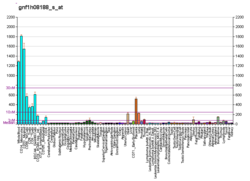Top Qs
Timeline
Chat
Perspective
VISTA (protein)
Protein-coding gene in the species Homo sapiens From Wikipedia, the free encyclopedia
Remove ads
V-domain Ig suppressor of T cell activation (VISTA) is a type I transmembrane protein that functions as an immune checkpoint and is encoded by the VSIR gene.[5][6][7]
Remove ads
Structure and function
VISTA is approximately 50 kDa and belongs to the immunoglobulin superfamily and has one IgV domain.[8][5]
VISTA is part of the B7 family, is primarily expressed in white blood cells and its transcription is partially controlled by p53.[8][9] There is evidence that VISTA can act as both a ligand[10] and a receptor[11] on T cells to inhibit T cell effector function and maintain peripheral tolerance.[5][8] Similarly, VISTA and TIM-3 may co-exist on macrophages infiltrating different human and mouse tumours where they can co-regulate immunotherapy resistance.[12]
Remove ads
Clinical significance
Summarize
Perspective
VISTA is produced at high levels in tumor-infiltrating lymphocytes, such as myeloid-derived suppressor cells and regulatory T cells, and its blockade with an antibody results in delayed tumor growth in mouse models of melanoma[13] and squamous cell carcinoma.[14] It is also up-regulated in tumour-associated macrophages in various malignancies, including melanoma, especially in immunotherapy-resistant human context.[12]
Monocytes from HIV-infected patients produce higher levels of VISTA compared to uninfected individuals. The increased VISTA levels correlated with an increase in immune activation and a decrease in CD4-positive T cells.[15]
As a drug target
There are several ongoing cancer immunotherapy clinical trials for a monoclonal antibodies targeting VISTA in advanced cancer.[16] Preliminary results of the phase I clinical trials show good safety tolerance and anti-cancer activity in patients with advanced tumours.[17] One of the best characterized ligands or binding partners for VISTA is PSGL-1, which binds VISTA with high affinity only under acidic conditions (pH<6.5).[18] One promising approach uses an antibody (SNS-101) that only binds to VISTA when the multiple histidine residues of VISTA are protonated inside acid tumors. This approach greatly improves the pharmacokinetics of the anti-VISTA antibody.[19] Another ongoing clinical trial involves a small molecule that antagonizes the programmed death-ligands 1 and 2 (PD-L1 and PD-L2), and VISTA pathways in patients with advanced solid tumors or lymphomas.[20]
Remove ads
References
Further reading
External links
Wikiwand - on
Seamless Wikipedia browsing. On steroids.
Remove ads





